Parador Torremolinos
As we near journey’s end (can Puffins tell where we’re going to yet and why?), the final photo from the previous edition of Nostalgia Album is reproduced below. Depicted, is an unprepossessing single-story tile-roofed building, rendered in white, that couldn’t possibly have survived the trillion tons of concrete deposited upon the Andalusian coast since my father and his parents visited in 1952. Or could it?
My grandparents, Edith and Elihu, stand beneath an arched entrance. Their heroic Ford 8 sits proudly to their right. Presumably, my father is standing on a driveway that leads to the main road which is in turn, presumably, the coast road from Málaga via Torremolinos to Fuengirola and beyond.
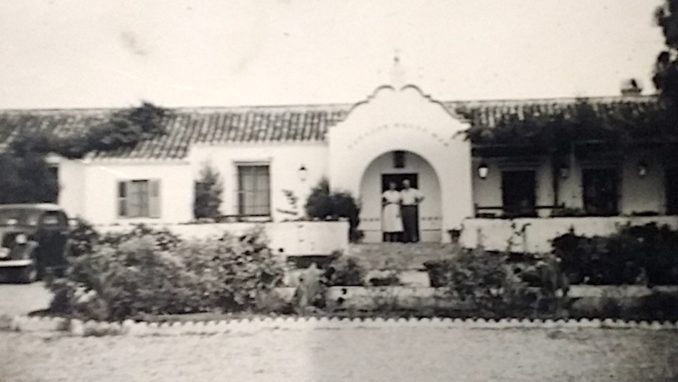
© Always Worth Saying 2022, Going Postal
Embossed around the arched doorway, and helpfully reproduced in a handwritten album caption, is “Parador, Montemar, Torremolinos”. Upon investigation, ‘Parador’ does not refer to the name of an individual hotel or even a chain of hotels, but to a type of hotel. The Parador was general Franco’s (given subsequent developments, we must conclude highly successful) attempt to boost the Spanish tourism industry.
Wikipedia defines the concept:
What is a Parador? A Parador (Spanish pronunciation [paɾaˈðoɾ]), in Spain and other Spanish-speaking countries, is a kind of luxury hotel, usually located in a converted historic building such as a monastery or castle, or in a modern building with a panoramic view of a historic and monumental city. Parar means to stop, halt or stay.
Further investigation reveals that another Parador is located close to another Nostalgia Album photograph, in the Ducal Palace at Lerma, 125 miles north of Madrid. Although worldly Puffins have suggested the Worth-Saying family fortune was about to be squandered at the gaming tables of Portugal’s Atlantic coast, it seems more likely to have been wasted (if wasted is the correct word) on the finest hotels in the Spanish-speaking world.
A provincial newspaper feature from 1955 adds more colour to the Parador concept and gives a clearer idea of the nature of Spanish tourism industry seven decades ago. In better times, when an English travelling gentleman stepping into 120-degree heat in tweeds was allowed to refer to Johnny Foreigner as ‘primitive’, the Birmingham Post’s Madrid co-respondent gushes,
“What pleasanter surprise can befall the weary tourist after a long day’s travelling over wide stretches of almost uninhabited plains and savage mountains, than to reach a romantic castle overlooking a charming but primitive little village and find that it is one of the state-owned Paradors [italics] a comfortable hotel with every modern comfort? This is but one of the surprises awaiting the visitor to Spain, a country which until not so many years ago was almost unknown to the foreign tourist.”
Of course, even in the halcyon days of Her Majesty’s provincial press, we all know the Birmingham Post didn’t have a Madrid co-respondent. Such copy will have been bashed out by a cub reporter, when not slowly starving to death in lodgings in Bescot, poised over a smoke-filled city centre office’s sit-up and beg typewriter. The cultural attaché at the Spanish Embassy in London having handwritten and personally addressed a fact sheet to the editor of every local rag in the land.
Thus the Generalissimo’s big scheme, no doubt calculated from the comfort of his own summer residence Death Star Parador in the Valley of the Fallen, was administered to the good people of Birmingham and beyond. In between the Carlisle Patriot’s stock prices and hound trail results, my father and his parents were delivered of a prescient call drawing them south.
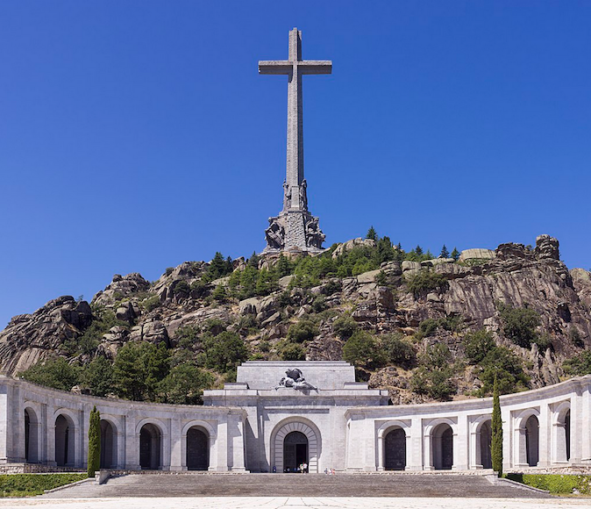
Valley of the Fallen, viewed from the esplanade,
Godot13 – Licence CC BY-SA 4.0
The accompanying statistics reveal that by 1955 Spain boasted 45 luxury hotels, 303 first-class hotels, 457 second-class ones and 437 of a third-class standard. In total, 56,467 rooms were available to travellers. ‘As a rule’ they were spotlessly clean and the food was excellent. The number of tourists in 1954 totalled two million with the British coming third in the list. By comparison, according to Statista, today the country enjoys 941,000 hotel rooms which, pre-pandemic, accommodated 84,000,000 visitors per annum.
Given the Nostalgia Album evidence of dusty roads, streets deserted except for dogs and cockerels, water in kettles being fetched from wells and empty winding tracks through tortuous mountain passes, your humble reviewer of photos was surprised that as many as 2 million visited. Having exhausted quantitative easing and Ukraine, the issue was discussed over the Worth-Saying breakfast table. My well-travelled oldest son drew a worldly conclusion from his own experience.
“Just because they went here, doesn’t mean they enjoyed it.”
Or perhaps it’s just that I’m too negative an observer? Later in the Birmingham Post feature, an ink-stained cultural attaché reaches the Andalusian coast,
“The road winds its way close to the brilliantly blue sea and passes through fishing villages whose houses are so sparkling with whitewash that they almost hurt the eyes; the white of houses is offset by scarlet geraniums which are found everywhere in profusion, by purple and red masses of bougainvillaeas, pink and white oleanders often growing wild, palm and orange trees, rows of aloes, and sweet-smelling jasmine.”
Gosh. Did Franco’s favourite and over-excited niece have a hand in this?
“Torremolinos is the main holiday resort and a considerable foreign colony lives there the whole year-round. There are hotels all along the coast, in some of which guests are accommodated not in the main building, but in separate little cottages in the hotel grounds.”
As well as castles and monasteries, the Parador were located along the coast in the type of idyllic High Chaparral pictured above and described by the Post. It was to such a luxurious establishment that my father and grandparents had arrived. Well deserved after a long journey, over 700 miles in Spain alone, on rough roads in a Ford 8. All well and good, but what became of the Torremolinos Parador?
Parador Torremolinos?
Reference to our friends at Google Maps shows a Parador near to Torremolinos beside Málaga airport, these days a golf course of some repute.
The oldest golf club in the Costa de Sol, in fact, the oldest golf club in mainland Spain, the Parador de Málaga course was designed by Scottish architect Tom Simson, whose historic works also include sculpting both Donald Trump’s Turnberry and the Honourable Company of Edinburgh’s Muirfield.
Opened by King Alfons III in 1925, the club (which borders a playa nudista) includes an old course and a links that have hosted several European PGA Tour tournaments.
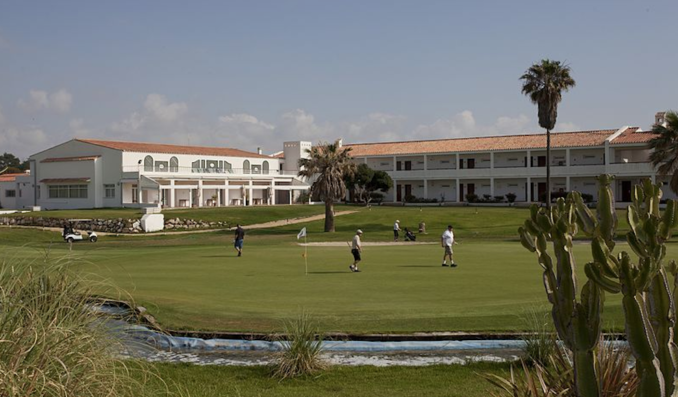
Parador de Málaga Golf,
Paradores – Licence CC BY-SA 4.0
Taking a closer look on Street View shows familiar but more modern low-rise white-washed buildings with pitched roofs. Close to the sea, the complex seems to be of chalets scattered around central buildings with some new wings attached. Is this the old Parador Torremolinos?
An internet search revealed an old postcard, definitely of the hotel in the family photo, and marked both with Málaga and Torremolinos. More rooms had been added to the right of the property. Is Parador de Málaga Golf Club the same place? A ‘where’s this’ social media request settled the issue. “Behind my house”, replied the helpful Mr Fuentes of Montemar, Torremolinos. “Inside the Doña Carlota Urbanization.”
The Parador Torremolinos has survived but not as a golf club between to Málaga airport and a nudist beach.
Parador Torremolinos!
The Parador has been beautifully preserved although encroached upon on all sides by the slab-sided concrete blocks of the Doña Carlota Urbanization. An aerial view gives a better appreciation of the layout with the original building being about 100 yards north of the Avenida Alessandri which one assumes to be the original coast road. To the northeast sits the Parque de la Bacteria that presumably means something else in Spanish. Two hundred yards south of the main road is the magnificent Playa de la Carihuela beach and promenade.
Now luxury holiday apartments, the booking websites reveal satisfied visitors award it a rating of 9.6 out of 10. A Miss Esperanza is much mentioned in the un-read comments which she prowls ‘in order to improve for next clients’. Although the booking website wouldn’t show me prices or let me pretend to book a room (the algorithm can smell a time-waster), an Airbnb in the same complex costs £158 a night.
Looking at the recent booking website photographs of the original restored buildings reveals a commemorative plaque. Although difficult to read in its entirety, it shows that the proximity of the apartments now known as Doña Carlota to the avenue now known as Alessandri is no coincidence.
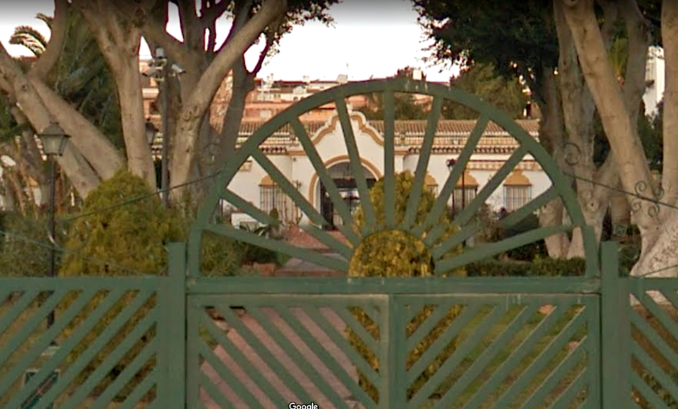
© Google Street View 2022, Google
Whyfore Doña Carlota and Avenida Alessandri?
In last week’s episode, long-suffering readers were informed I am a monoglot. This isn’t strictly true but might as well be. My Spanish is dreadful and derives from loan words adopted in the Philippine provinces thence re-defined and differently pronounced. Added to this, my language skills get worse the older I become and the harder I try. What follows is my interpretation of an old newspaper cutting that has slipped into my possession.
Both the Doña Carlota Urbanization and the Avenida Alessandri are named after the same person: Carlota Alessandri.
Born in 1880, in 1934, already in her 54th year, she borrowed 100,000 Pesos from a bullfighter and built the very first hotel in Torremolinos, a seven-room establishment originally called the Montemar Inn but subsequently renamed to our very own Paramor Montemar, Torremolinos. Originally there was no running water. Spring water arrived daily in buckets. Guests were met at Málaga and brought to the hotel by mule and cart.
Civil War hampered the development of the site, but an extension was completed in 1943 with the Parador becoming ‘the first great reference point for tourism on the Costa Del Sol’.
A devout Catholic, Alessandri gave land to the Carmelites who constructed a church, nursing home, nursery and a free school for hotel employees. Pope Pius XII blessed Carlota’s enterprise during a private audience held on her behalf. Carlota had two daughters; Maria Ángeles and Maria Rosa.
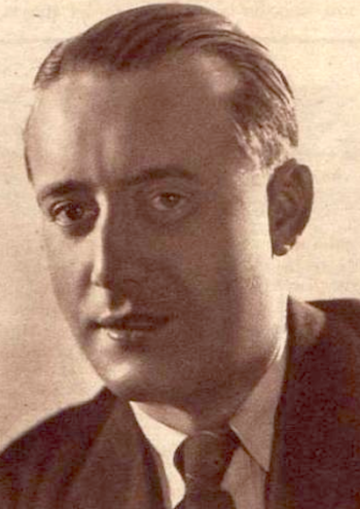
El dramaturgo y director de cine español Edgar Neville,
Unlnown photographer – Public domain
Maria Ángeles married young. On October 28th 1925, at the age of 19, she wed Edgar Neville Romrée whose father was an English industrialist and whose mother was a renowned beauty and daughter of the Count of Berlanga de Duero. The family seat lies close to the previous Nostalgia Album port of call of Aranda de Duero. Because of his social position, Edgar was offered a position in King Alfonso XIII’s diplomatic service. Deciding himself to be a Spanish attaché to California, Edgar decamped to Los Angeles where he made Spanish language versions of Holywood films alongside his beautiful young wife.
Returning to Spain, he produced propaganda films for General Franco’s Nationalists while she founded the theatre made famous by her initials, ARA. Graduates of her company include Fiorella Faltayno (star of The Shadow of the Cypress is Long), Tito Valverde (famous for Sunrise, Which Is No Small Thing) and Antonia Bandaras (Puss in Boots in Shrek).
I wonder what they thought when the saddle sore Worth-Sayings, travelling with their own kettle, arrived in a Ford 8?
As well as being close to the beach, the Parador is only a twenty-minute drive from Fuengirola and, continuing in the same direction, about 60 miles from our final destination. Journey’s end has already been correctly predicted in Puffin’s un-read comments below these un-read articles. As soon as we headed south of Madrid, it was obvious where we were going. But why? Find out next time on Nostalgia Album!
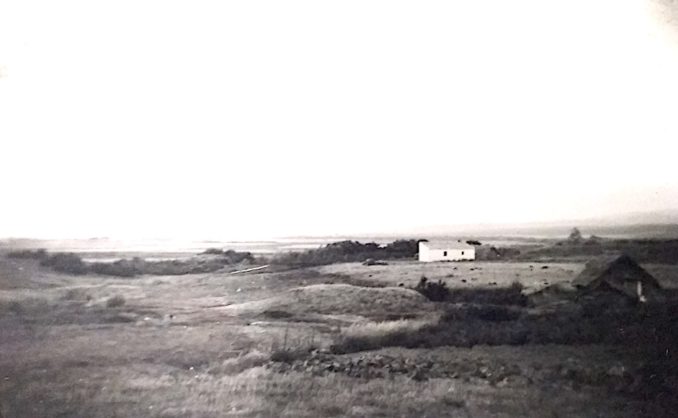
© Always Worth Saying 2022, Going Postal
© Always Worth Saying 2022


